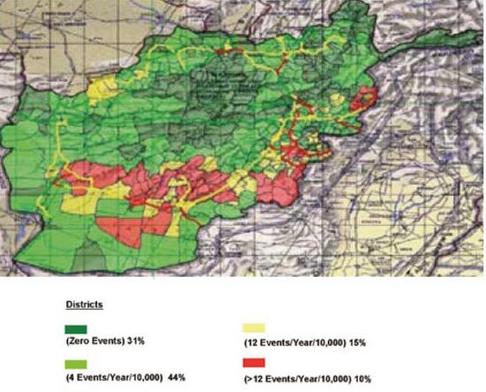NATO has made a renewed push to secure Afghanistan after attacks rose to their highest levels since the Taliban regime of Mullah Omar was ousted in early 2002. At this week’s annual NATO summit in Bucharest, Bulgaria, members committed additional troops to Afghanistan. France will send a battalion of infantry – more than 700 troops. Georgia will send 500 soldiers and Poland will send 400 additional soldiers. Czechoslovakia has committed 100 elite counterterrorism troops. Romania, Italy, Greece, Spain, and Britain agreed to send an unspecified amount of additional troops. The US will deploy two additional Marine battalions and supporting elements this year and committed additional forces in 2009. Canada has committed to staying in Afghanistan through 2011 after threatening to withdraw if NATO members did not step up and shoulder their fair share of the fighting.
NATO has also secured supply line through Russian territory to resupply forces in Afghanistan after fears that the Pakistani supply lines through the Khyber Pass would be interrupted by Taliban attacks in Pakistan.
According to NATO statistics, “More than 75% of [Afghanistan] experienced less than 1 security incident per quarter per 10,000 people, supporting the assessment that the insurgency is not expanding across [Afghanistan]. 70% of the events occurred in 10% of the districts. The population of these districts is less than 6% of the population of [Afghanistan].” NATO attributes the increase in violence to increased operations by NATO forces.
Data provided to The Long War Journal by Vigilant Strategic Services Afghanistan (VSSA) shows that the attacks by the Taliban and “Anti-Government Elements” such as Gulbaddin Hekmatyer’s Hizb-I Islami Gulbuddin and other allied groups have increased from the first quarter of 2007 when compared to the first quarter of 2008. The eastern, southeastern, and southern provinces bordering Pakistan still remain the most violent areas in Afghanistan.









8 Comments
Good stuff, adds some perspective.
From Bill’s link to the NATO report:
The ANA already has 13 out of 15 planned manouver combat brigades in the fight level C3 or better. {There is a 16th Brigade that serves as Army HQs + Aviation assets planned}
77 ANA battalions include combat battalions (45 in the 15 combat brigades) + noncombat battalions (15 combat support bns {Bde HQs+EOD+Engineering+commando Scouts} + 15 combat support service bns {supply/transport/maintenance} + 2 battalions for the Army HQs brigade.
Each of the 5 Corps HQs (division HQs equivalents) do not count as a battalion in the 77 battalion figure.
50 out of 77 battalions are C2 or C1. 1 Corps HQs (division HQs equivalent) + 1 combat battalion are C1.
15 other battalions are expected to graduate to C1 in the coming weeks.
Other points to note are that total attacks in RCT-East are down (kinetic gun-fire related violent incidents are down 90% while IEDs are up 15%.) Attacks in RCT-South are up. There aren’t many attacks on RCT-North, RCT-West, or RCT-Kabul.
Hmm. What are the rules of engagement going to be for these new troops? Are they going to be actively pursuing Taliban/AQ positions?
It would be interesting to see an overlay of the Opium gowing regions.
I would not be suprised if they are close to the fighting.
Thanks for the excellent graphic work and stats.
SoCalSooner, ‘poppy fields” no doubt troubled area. Criminals are criminals. It would be a good look at how it works hand in hand with terrorist.
FARC in Columbia is same issue.
It is realy pathetic to see the letter by Democrats to presidnet today. What they were doing all the last 8 years. These democrats,Media and the ruling republicans have been fooling the American Public by using the term “AFGHANISTAN/PAKISTAN BORDER”. It is Pakistan and pakistan only with its Military leadership backed by SAUDI ARABIA AND UAE. The earlier americans understand this, it is better.
Interesting. This seems to closely track a graphic I made last November plotting the locations of a few weeks of air strikes.
http://peacelikeariverblog.com/?p=62
Without Pakistan, the Taliban would crumble. Without support from elements of the Pakistan government the Taliban would cease to exist. So, the fighting in Helmand Province is really a side-show. If Pakistan wanted to, it could immediately arrest the top 50 Taliban leaders and shut down the whole operation.
The key phrase, however, is, “if Pakistan wanted to.” It does not, neither the government nor the people for some very convoluted reasonings most of which border on extremes of paranoia, schzophrenia, hatred of the West and xenophobia.
Until Pakistan decides what it is, a liberal captialistic democracy, or a fundamentalist theologic sharia-law dictatorship, nothing will be done, and the “line in the sand” – the Durand line, will continue to be nothing more that a new “Cambodian frontier” demarkation of a safehaven.